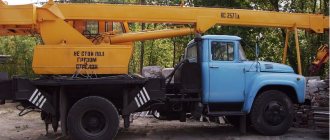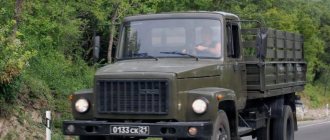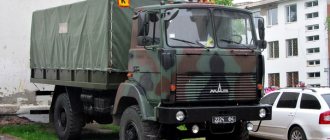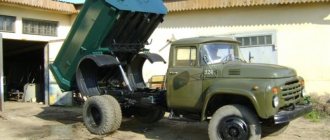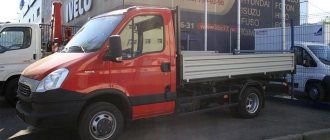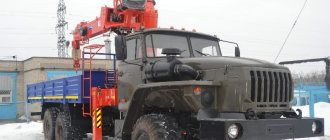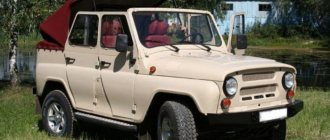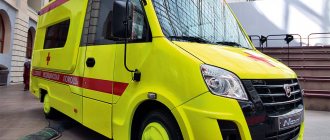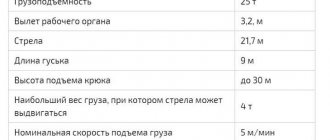5.3.1 Brake systems of ZIL vehicles
The car is equipped with three braking systems that allow you to reliably brake the car and trailer equipped with both single-line and two-line drives.
The service braking system allows you to control the movement of the vehicle and stop it reliably, quickly, regardless of the speed and load, or on an uphill or downhill slope. The brake drive is pneumatic, with separate braking of the front and rear wheels (Figure 5.24). The service brake system is controlled using a brake valve.
The parking brake system keeps the vehicle stationary on a level road or slope. The drive of the brake mechanisms of the parking brake system is mechanical, from brake chambers with spring energy accumulators installed on the rear axle. When the vehicle moves, the power springs of the energy accumulators are compressed by air pressure. When the air pressure in the cylinders of the energy accumulators drops, the springs activate the brake mechanisms of the rear wheels. The parking brake system is controlled by a manual brake valve located in the cab to the right of the driver's seat.
Figure 5.24 – Diagram of a pneumatic brake drive
1 – front brake chambers; 2, 15 – air cylinders of the service brake system; 3 – pneumoelectric Danish pressure reduction; 4 – condensate drain taps; 5 – air cylinder for moisture condensation; 6 – compressed air distributor; 7 – single safety valve; 8 – triple safety valve; 9 – pneumoelectric brake signal sensors; 10 – control outlet valves; 11 – valve of the service brake system; 12 – pressure regulator; 13 – anti-freeze fuse; 14 – rear brake chambers with spring energy accumulators; 16 – valve for parking and spare brake systems; 17 – pressure gauge; 18 – accelerator valve; 19 – two-line valve; 20 – brake force regulator; 21 – compressor
A spare or emergency brake system ensures that the vehicle stops in the event of a complete or partial failure of the service brake system. When the spare brake system is turned on, the air pressure compressing the power springs of the energy accumulators changes, and thus the intensity of braking is regulated. The spare brake system is controlled by the same brake valve as the parking brake system.
In the event of an emergency drop in pressure in the parking brake system, the power springs of the energy accumulators are activated and the vehicle is braked. In addition to the pneumatic system, there are screws for mechanical release of the brakes, built into the cylinders of the energy accumulators.
The condition of the brake systems is monitored using a light and sound alarm system, the sensors of which are installed at various points of the pneumatic brake drive, as well as control outlet valves.
The mechanisms of the service brake system (Figure 5.25), a drum type with two internal pads, are installed on all wheels of the car. The brake mechanisms installed on the wheels of the rear axle are common to the service and parking brake systems.
The mechanisms are mounted on calipers, which are bolted to the flanges of the front axle steering axles, and connected to the rear axle housing flanges with rivets. Two brake pads with friction linings attached to them, made along a crescent profile in accordance with the nature of their wear, rest on eccentric axles fixed in the caliper. The axes of the shoes with eccentric supporting surfaces allow the shoes to be correctly aligned with the brake drum when assembling the brake mechanism. Brake drums are attached to the wheel hubs.
When braking, the pads 3 are moved apart by the expanding fist 8 and pressed against the inner surface of the drum 9. Rollers 7 are installed between the expanding fist and the pads. The pads are returned to the released state by tension springs 5.
The expansion knuckle shaft rotates in a bracket attached to the caliper with 1 bolts. At the splined end of the expanding fist shaft 8 there is an adjusting lever connected to the brake chamber rod by a fork and a pin. The shield, bolted to the rear axle caliper, protects the brake mechanism from dirt, and the oil deflector 10, attached to the inside of the brake drum, protects the brake mechanism from lubricant from the hub.
Figure 5.25 – Brake mechanisms of the service brake system
a – rear wheels; b – front wheels; 1 – caliper; 2 – block axis; 3 – brake pad; 4 – friction lining; 5 – tension spring; 6 – roller support; 7 – roller; 8 – expansion fist; 9 – brake drum; 10 – oil deflector
The adjusting lever is designed to reduce the gaps between the pads and the brake drum, which increase due to wear of the friction linings. The body of the adjusting lever contains a worm gear with a splined hole for installing an expansion knuckle and a worm with an axle on the shaft. The worm axis is fixed by a locking device consisting of a ball and a spring. The gear is held in place by caps attached to the housing. When turning, the worm turns the gear with the shaft and expansion fist, which pushes the shoes apart and presses them against the brake drum. When braking, the adjustment lever is turned by the brake chamber rod. The intensity of braking depends on the compressed air pressure and the stroke of the brake chamber rod.
Compressed air from the compressor (Figure 5.24) through the pressure regulator, condensate freeze guard and air cylinder flows to the double and triple safety valves, which, in turn, distribute the air, filling the air cylinders of the following independent brake circuits:
the first – the brake mechanisms of the front wheels;
the second – the brake mechanisms of the rear wheels;
the third – parking and spare brake systems, as well as a combined drive of the brakes of a trailer or semi-trailer.
All air cylinders have condensate drain valves, and pneumatic sensors for light indicators of compressed air pressure drop are built into these circuits.
A two-pointer pressure gauge is connected to the air cylinders of the brake drive of the service brake system.
To check the operation of the brake systems, control outlet valves are installed at various points of the pneumatic brake drive, to which portable pressure gauges are connected.
The first circuit includes the air tank, pressure drop sensor, lower section of the brake valve, front brake chambers and control valve.
Device
The cabin has 3 seats, 2 doors, panoramic glass, which provides excellent visibility. Large rear view mirrors are located on brackets. Door windows can be manually lowered and secured. The doors open at right angles, which is convenient for the driver and passengers. The cabin is equipped with large steps.
The height of the cabin is 2700 mm, it can be equipped with a berth. The steering has a mechanical and hydraulic drive. The hydraulic distributor and cylinder help improve steering control. Modern heating and ventilation systems have been installed.
The car is equipped with a 5-speed gearbox. The cardan system includes a chassis on which 2 shafts and intermediate supports are installed, which are connected by crosspieces. The load is transferred to the axles using the drive axle.
The supporting structure consists of a frame made of 2 metal channel beams. Longitudinal sections are fixed with cross members. Smooth movement is ensured by the design of the axle suspension. In the front and rear parts of the structure there are springs with shock absorption.
The rear springs are supplemented with metal sheets for strength. The truck is compatible with a large number of additional add-ons. The most commonly used emergency repair equipment includes a diesel generator mechanism with a repair shop and a fuel supply. The universal chassis allows tool boxes to be placed underneath. The machines are used to perform repair work at remote sites.
Ambulance vehicles, fuel tankers and garbage trucks, hydraulic lifts, tankers, loaders, dump trucks, bunker vehicles and other equipment are represented by this truck. The car can be used on any type of road.
The machine is characterized by increased maneuverability, maneuverability, operational reliability and ease of maintenance.
- power supply with standard connectors;
- versatility of the coupling device;
- connecting trailer brakes to vehicle systems.
The machine can transport bread, food, industrial products, frozen foods (refrigerated trucks). Hydraulic lifts can be used in the construction and installation of structures.
Brake system
The vehicle's braking system consists of 3 circuits and includes: a service brake with pneumatic control and a 2-circuit hydraulic system along the axles on the front and rear wheels. The axles have drum shoes with the possibility of installing anti-locking. There is a parking and spare brake with a drive circuit, pneumatic transmission, and drum shoes. If the cargo chassis is used as part of a road train, then the circuit is equipped with a crane to control the trailer brake.
Electrical equipment
The vehicle's electrical system is single-wire, with a voltage of 12 V. The ignition has a contact-transistor design. Starter voltage is 12 V, remote control and electromagnetic load relay are installed.
There is a 12 V battery, brand 6-ST-81, with a capacity of 81 A/h. The G-130 series alternating current generator creates a direct current of 28 A and a power of 350 W. The same voltage is maintained at different speeds using an electromechanical relay and an electronic control circuit.
The electrical equipment can be equipped with additional options: a pre-heater to make starting the engine easier in cold weather. A bed heating system can be installed. An upgraded ignition circuit with microprocessors is installed. The electrical circuit makes it possible to install an insulation cover and a recoil bar.
Transistor switch
The transistor switch is designed to switch the electric current in the primary winding of the ignition coil (breaking the primary circuit of the ignition coil at the required moment by turning on a large ohmic resistance of the output transistor).
The transistor switch is installed on the left wall in the car cabin. It should be borne in mind that the transistor switch can only operate at an ambient temperature of no higher than 70 °C and no lower than minus 60 °C.
The transistor switch cannot be repaired under operating conditions and, in case of failure, is replaced with a new one.
When checking the functionality of the devices of the contact transistor ignition system, open the contacts of the distributor 4. (see Fig. 9-16), turn on the ignition and check the voltage. With serviceable electrical wires and serviceable devices, the voltage at the terminals of additional resistor 2 of the ignition coil and at terminal “P” of the transistor switch should have the following limits:
- At the terminal of the additional resistor "B" 12.0...12‚2 V, at the terminal "VK" - 9 V, at the terminal "K" - 7...8 V.
- At the ignition coil terminals - 7...8 V.
- At terminal “P” - transistor switch - 3...4 V.
switch zil
If the wires and devices are in good working order, but there is no voltage at the “P” terminal of the transistor switch, this will indicate that the transistor switch is faulty and should be replaced.
“In the case when there is no spare transistor switch available, the ignition system can be converted to a non-transistor one by installing a capacitor and ignition coil B 114-B on B13 with its additional resistance.
Specifications
ZIL-433362 has the following technical characteristics:
- Wheel formula - 4x2.
- Dimensions: length 6.6 m, width 2.4 m, height 2.6 m.
- Maximum cargo weight is 6830 kg.
- Vehicle weight - 3945 kg.
- The permissible chassis weight is 11200 kg.
- The maximum weight of the road train is 19200 kg.
- Permissible load on the road surface from the curb weight through the tires: front wheels - 21750 N, rear axle - 17700 N.
- The greatest load on the road surface from the total weight of the vehicle through the tire of the front wheels is 30,000 N, the rear axle is 82,000 N.
- The turning radius is 6.9 m.
- The highest speed with the full weight of the truck is 90 km/h, with the full weight of the road train - 80 km/h.
- Fuel tank volume - 170 l.
Engine
The car is equipped with a ZIL-508 carburetor engine. This is an 8-cylinder engine with a capacity of 6 liters. Motor power 150 hp, or 110 kW. Engine speed is 3200 per minute. The torque is 41 kgf/m. The motor design is equipped with valves located at the top. A total of 16 valves are installed. Engine weight with additional equipment is 640 kg.
Modifications
Thanks to the universal design of the chassis, there are a large number of add-ons, which made it possible to create many modifications of the ZIL-433362 vehicle.
The ZIL-433362 aerial platform is a hydraulic lift equipped with a boom, used for lifting loads. The AKMP-3 model is used to clean roads in cities and airports. In summer, this unit cleans the roadway from dirt and dust, and in winter – from snow. The technical characteristics of the garbage truck allow the installation of an additional kit for cleaning the pipe surface. The device can be used to extinguish a fire.
The ERMZ asphalt distributor is designed for transporting bitumen and applying it to the surface of the roadway during road repairs. Used for transporting fuel oil, peat and lubricants.
ATs-3.5-40 is a tanker truck that is used as a fuel truck or when extinguishing a fire. Fire tankers can deliver approximately 2 tons of foaming water.
ZIL-433362 KO - garbage truck for unloading garbage from containers. When working, use a push plate with the body folded down. A manipulator is installed on the side. The machine has high maneuverability.
The municipal watering machine 713 01 520 KO on the ZIL-433362 chassis is used for watering plants in parks, squares and streets. KO-520 is also used for washing road surfaces.
Reviews and prices
A new truck costs 1.2-2 million rubles. Used cars cost 0.8-1.5 million rubles. Cars that have been in operation for more than 12 years cost 250 thousand rubles.
Our organization uses a fire tanker based on a ZIL truck chassis. This equipment is characterized by high strength, reliability and good cross-country ability. The unit was used many times during fires and showed high technical data.
I work on a ZIL refrigerated truck. The machine transports chilled products. We serve retail stores, meat processing plants and other organizations. The truck is maneuverable, has excellent speed and load capacity.
Description of the ZIL-433362 model
The 433362nd model was originally conceived as a station wagon chassis, on which a variety of body superstructures or platforms (sided, without sides), vans, including isothermal ones, can be installed. Therefore, the field of operation is extensive - from MDC to product transportation. Among the “classics” of middle-class trucks, the domestic “Amur-531310” is one of its analogues. The price for the chassis is about 600-700 thousand rubles. Used versions with add-ons cost up to one and a half million rubles, new ones - within 2 million rubles (depending on the type of add-on).
Brake system ZIL-130
The brake system of ZIL 130-431410 vehicles can be multi-wire or single-circuit, depending on the time of production of the vehicle. Brake system diagrams are shown in Figures 12-15 and 12-16. The multi-circuit brake drive of ZIL-431410 vehicles differs from ZIL-433360 vehicles in the number of devices used and their connection. The brake drive devices themselves are the same. By car
multi-circuit braking system
Diagram of a service brake system with a single-circuit undivided drive
single-circuit braking system
Braking systems, as we see in the pictures, come in 2 types. We will make a multi-circuit system similar to a single-circuit one. Let's remove unnecessary taps, which we can say are not needed for the operation of the brake system. Let's look at the third picture. Here I want to show how I made a single-circuit system from a multi-circuit ZIL-431410 system.
I removed valves such as: a brake force regulator, a trailer brake system control valve with a two-wire drive, a single safety valve, pneumatic-electric pressure reduction sensors, connecting heads for trailer brake drives. As they say, the simpler, the more reliable. The fewer air pressure tubes, the less air will bleed.
rebuilt brake system
In the upper and lower pictures, look at how the diagram of the pneumatic brake drive is made and you will see the difference. Using this diagram, you will make all the connections, I think you will figure it out, there is nothing complicated.
Electrical diagram - ZIL-433360:
11.5208 111.3714010 114-3730166 118K-3709410 118K-3710470 118K-3730024 120-3715020-B 120-3722150 120-3722150 130-3701010-21 130-3702010-11 130-3703010-A 130-3705010-B 130-3705050 130- 3706010-30 130-3707010-A 130-3707090-V 130-3707095-V 130-3707100-V 130-3707105-V 130-3707110-V 130-3707115-V 130-3707118-B 130-3707120-B 130- 3707125-B 130-3708110-A 130-3711010 130-3711010 130-3712010-B 130-3712010-B 130-3715060-A 130-3715060-A 130-3716010 130-371 6011 130-3721020-02 130-3721225 130- 3721300 130-3722105 130-3722210 130-3724172-A2 130-3734010-01 130-3761026-01 130-3808012-A 130-3808014 130-3827010 130С-372 2105 131-3703140 131-3703200 131-3710136-11 131-3714320 -B 131-3724316 131-3733010-B 133ВЯ-3803135 133ГЯ-3722105 161.3801 2402.3716010 25.3802 35.5205 375Я4-3707150-В 3802.3710000- 04 3802.3710000-06 3802.3710000-10 40-3709000 431410-3720010 431410-3722075 431410-3723043 431410-3829030 431410 -3830300 431410-3830300 4321-3724031 4321-3724031 4331-3708500 4331-3709412 4331-3710510 4331-3723100 4331-3724032 4331-3726 026-01 4331-3829010 4331-8201055 4331-8201055 433360-3724010 433360-3724022 433360-3724044 433360 -3724044 433360-3724045-10 433360-3724074 433360-3724080 433360-3724081 433360-3724081 433360-3724102-10 433360-3724375 4333 60-3724594 442160-3724010 442160-3724044 442160-3724045-10 45 7372 0043 45 7374 3331 45 7374 3331 45 7374 3331 494560-3724044-10 5802.3747000 6302.3761000 66-3709000 A-32356 VK416B-3709000-01 ST230K1-3708000
List of components from Electrical diagram for ZIL-433360
Parts diagrams are for reference purposes only! We do not sell all spare parts from the electrical diagram for ZIL-433360 presented in this list. If there is a “Show prices” link in the right column, these spare parts from “Electrical equipment diagram” are on sale. Availability in warehouses for details and prices, see the product card. If there is no “Show cost” link in the right column, we do not sell such parts and do not accept orders for them.
| № | Part code | Name | Part Information | Show all prices |
